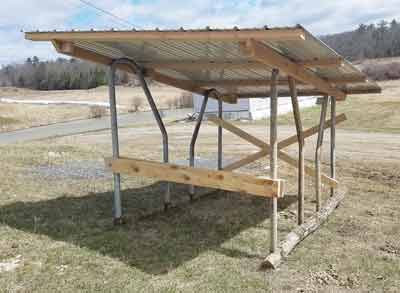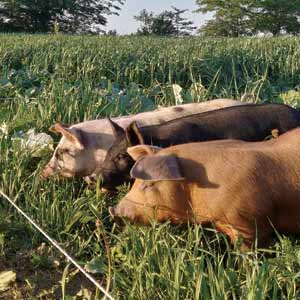By John and Holly Arbuckle
We consistently hear how pigs can’t be regenerative. We would edit that to say this: While pigs don’t fit into the regenerative equation as smoothly as ruminants, we can look for strategies to improve land, even with pigs.
When it comes to regenerative grazing, it is useful to look at how pigs compare and contrast to beef cows. Let’s contrast first:
• If you want pigs to grow at a reasonable rate, you’ll have to give them something other than just grass.
• If you want them to create positive animal impact on your cropland or pasture, you have to move more than just the fence.
This second topic is what we are talking about in this article.
Each one of our temporary paddocks is big enough to handle pigs for three to seven days. These are enclosed by a single strand of hotwire held aloft by step-in posts.
Within each paddock are a handful of elements providing for the needs of the pigs:
• first and foremost is abundant, well managed, clean grass.
• shade/rain shelters
• a water trough
• lots of movable feeders
One of the keys to getting pigs to improve the sward is to move all of these elements as needed. But not all the elements need to be moved at the same pace.
For example, we move the feeders two times per day, shade/rain shelter every day, and the waterers every couple of days. This is not a prescription, but rather a guideline to help create the effect we want to see.
No bare soil
To our eyes, a regenerative pig pasture has no, or at least very little, bare soil. We all know that bare ground is not regenerating anything. The bullseye to shoot for is pasture protected by a 100% vegetative cover of sod-creating plants.
We do not achieve this in every cycle. Unexpected rainstorms happen, ground cover is lost, and rampant pugging can occur.
When mistakes happen, we unroll rotten hay on the bare soil after the pigs have left. Any cover will do, although rotten hay provides a cost-effective armor layer while we wait for the grass to return.
Still, the more you can achieve continuous groundcover, the better the soil regeneration. Sometimes to hit the bullseye you have to aim a little higher than the mark!
Our pig runs are typically rectangular. When the pigs walk into the fresh paddock, they are immediately greeted by their feeders, waterers and shade structures. Moving the feeders morning and evening, and the shelter each day, keeps all elements of the system in a relatively straight line and advancing at the same speed. The goal is to have all of them inch-worming toward next week’s paddock.
This movement means that, all other factors being equal, pigs are impacting the land uniformly. When we set it up this way, the animals tend to concentrate close to the feed, shade and water resources they desire. They do roam about grazing the entire area, but this grazing is of low intensity and somewhat haphazard.
The line of elements moves across the paddock like a giant, 200-foot wide rolling pin. It mashes all the vegetation and undesirable weeds flat to the ground via grazing, hoof action and pigs just being pigs. This hits grass reset buttons marvelously well, especially since we are offering some form of imported feed and most of their droppings are a net gain to the soil.
With grazing ruminants that aren’t fed grain, the manure was grass already growing in the field. With pigs, the brewer’s grains, pumpkins or plain old pig feed they ate are adding nutrients that weren’t there before you carried the feed to them. It is somewhat like the chicken tractor idea, only it covers a full acre at a time, and the impact is created by using the hotwire first, and the movement of the resources within the paddock second.
Our farm has several wet areas, and sometimes we see the ground there as being simply too wet for any animal impact to be positive. In these cases the step-in posts and geared reel system used for creating temporary paddocks serve us very well.
We are able to create any weird, amoeba-shaped paddock the situation calls for to exclude animals from delicate ground. This fencing strategy also allows us to make best use of the fluid nature of adaptive grazing by tinkering with the variables of paddock size and shape.
Experimenting with shelter
The shelter part of this is the most problematic when it comes to keeping your equipment mobile. Over the years we have tried many things.
Simple metal Quonset structures are readily available in some places and provide adequate shelter when the weather is not extremely hot or cold. They should not be relied upon for shade out on open fields in hot climates. They are somewhat like an oven in those situations.
The more comfortable a pig is, the more efficiently it will convert its feed ration to weight gain or producing piglets. A cold, shivering pig will burn calories trying to warm up, while a hot, panting pig will do the same in trying to cool down.
When we see a pig panting really hard at rest on a hot summer day, we imagine every labored breath as throwing a bit of corn into a river. If all 300 pigs in a spring crop are panting their way through the summer, we might as well be auguring a steady stream of corn into the landfill.
If there are cost effective steps that allow pigs to live comfortably, we need to take them. One that we take regularly is to put their shade structure in the shade. This may sound unnecessary, but it helps.
Most places in a savanna-style pasture are not shaded all the time. Your pigs will be more comfortable if the shade structure is placed in the shade of a tree from midday to late afternoon.
If you make a habit of extending this way of thinking through the very cold, windy, wet and hot times, you can expect your sows to have slightly more babies, your butcher pigs to gain at a slightly better rate, and for you to make more money.
Our butcher pig shelters are homemade contraptions that look a lot like a heavily built tool shed with no walls or floors.

We built them on skids cut from rot-resistant wood, and they can be moved easily by horse or vehicle. The uprights were originally bars from freestalls, and the lumber in the roof frame is from a local mill. The roof is made from white, reflective barn siding.
In wet weather we throw down some old, rotten hay to keep the pigs out of the mud. The uprights can be wrapped with a heavy greenhouse shade cloth to keep some wind, rain and sun out.
In warm weather several of these can be set up close together and side by side. Custom-made greenhouse shade cloth with metal grommets can be attached to both inside corners of two adjacent structures, creating double the amount of available shade for a fraction of the cost of another shelter. These structures remain very mobile.
Even more mobile is our prototype shade structure. This is a 20- by 30-foot canopy built on hay wagon axles. It is extremely mobile, and on flat ground can be pushed by hand. Its only real disadvantage on hilly ground shows up if the pigs happen to remove the blocks in front of the wheels.
Then a strong wind can blow the shade like a sail boat on the ocean, sending it racing downhill, tearing down the fence and crashing into a gully, only to be discovered the next day when the old lady next door calls and says your pigs are eating her daffodils.
Everything is mobile
As in so many things, the possibilities here are as numerous as our imagination allows.
In the end, on our farm everything other than the winter housing is mobile: fencing, water lines, waterers, feeders and shade/rain shelters.
If we can imagine our pig herd as a giant roller/crimper moving in a slow cycle around the farm, and build our infrastructure accordingly, we can reasonably expect pigs to work as partners in our goal of increasing the soil’s resiliency within our lifetimes.
John and Holly Arbuckle manage pasture-raised pigs and operate Roam Snack Sticks, LLC, from their farm near Newcastle, Maine.

